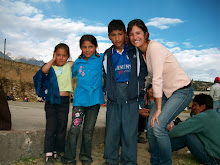In 1970, an earthquake the magnitude of 7.7 on the Richter scale hit off the coast of Peru and devastated the Andean department of Ancash, taking the lives of an estimated 80,000 people. Another 3 million were affected, making the quake the largest natural disaster in Peruvian history. Huaraz, Ancash’s capital city, crumbled to the ground. Ancash’s smaller villages were demolished; the adobe houses and buildings didn’t stand a chance. The quake destabilized the northern wall of Mount Huascaran, and towering at over 22,000 feet, the wall of the glacier broke off, creating a landslide of epic proportions that buried the urban town of Yungay. Only a couple hundred children and teachers survived the Yungay landslide because they were hiking on hills above the city, above the destructive reaches of the mud, ice, and debris that buried their town and families in the blink of an eye. The surviving children were dispatched to orphanages around the world.
Almost 40 years later, another massive earthquake devastates the impoverished island nation of Haiti. The statistics are shockingly similar: both Ancash and Haiti were impoverished areas before the earthquakes, both quakes left over 50,000 people dead and around 3 million affected, and both quakes completely destroyed basic and vital national infrastructure.
Today, Ancashinos sit in their adobe houses listening to the news come in about Haiti and are bitterly reminded of a not so far away past when they were living the same horror. Politicians and international aid workers should turn to Ancash as a developmental case study to help maneuver the unsteady waters of Haiti. What happens to an already impoverished society when a natural disaster strikes?
The earthquake in Ancash affected every aspect of the campasinos’ life, from family, culture, economy, infrastructure, and personal identity. Homes turned to dust. Crop fields were destroyed. Livelihoods were lost. Parents, siblings, and friends perished into the ground. Communities were destroyed. Access to drinkable water became the key to survival. The shock these losses take on a person’s self-esteem and self-worth are immeasurable. Peru lacked the resources to help their own people and turned to the outside world for rescue. What resulted in Ancash was a massive influx of international aid and support; richer, developed nations and organizations like the Inter-American Development Bank and the World Bank sent food, medicine and manpower in hoards. Survivors of the earthquake in Tumpa, my Peace Corps hometown, tell me about the planes that would drop boxes filled with clothes and medicine out of the sky.
One of the major challenges Peace Corps volunteers in Ancash face today is what we call the “culture of receiving.” Since 1970, Ancashinos have become accustomed to receiving international aid, mostly in the form of money. Whether the financial aid comes from NGOs with health, educational or micro-business missions, or from mining companies seeking to pacify exploited communities with quick and glamorous development projects, Ancashinos are in the habit of receiving money. Eager Peace Corps volunteers who are broke by default seek opportunities to start grassroots development projects, but often are not taken seriously, because to the Ancashino eye, a Gringo equals a greenback. Starting sustainable development projects in the Ancash communities without applying for grants is difficult and rare. And this might be because of how the outside world reacted to the earthquake of 1970.
When a national disaster strikes, basic human morality implores those of us capable to help those of us in need. International financial aid and involvement over a period of time is certainly necessary after major natural disasters wreak havoc on impoverished societies like Ancash and Haiti. But once the proverbial dust has settled, is continued international aid sustainable? When does international financial aid stop helping and start stripping a society of its national fabric and sovereignty? What happens to national and personal responsibility and self-esteem? In Tumpa, I often encounter a general lack of motivation, low self-esteem and apathy in the townspeople. Is 40 years of outside financial involvement more beneficial or detrimental to the growth and development of people from societies like Ancash? Did our morality in 1970 take a long-term demoralizing effect on these people?
Alternatives to long-term international financial involvement in response to natural disaster situations could include development programs like the Peace Corps Response, whose volunteers donate a few months to a year to educate people on healthy lifestyle techniques or micro-business strategies to help in the transition from crisis situations to peace. More widely known is the Peace Corps, whose volunteers live and work in developing countries partnered with host country nationals who seek to empower positive change and growth in their own communities. One human being extending a helping hand to another, offering knowledge instead of cash, is a resource that should not be underestimated. The international community should examine alternative options to financial aid that help developing communities transition to build their own countries with dignity so the citizens can really “own” their development.
Despite our academic knowledge, history continues to repeat itself. The role of international aid in times of crises like these must be examined carefully. If the Haitian people want to become a sovereign, self-sufficient, developing nation, the international community might examine appropriate alternatives to providing aid other than throwing money at the problem. Otherwise the Haitians might rely too heavily on financial support for the foreseeable future, obstructing the way for organic national development.
*Special thanks to Tim for inspiring me to write this.
11 years ago









